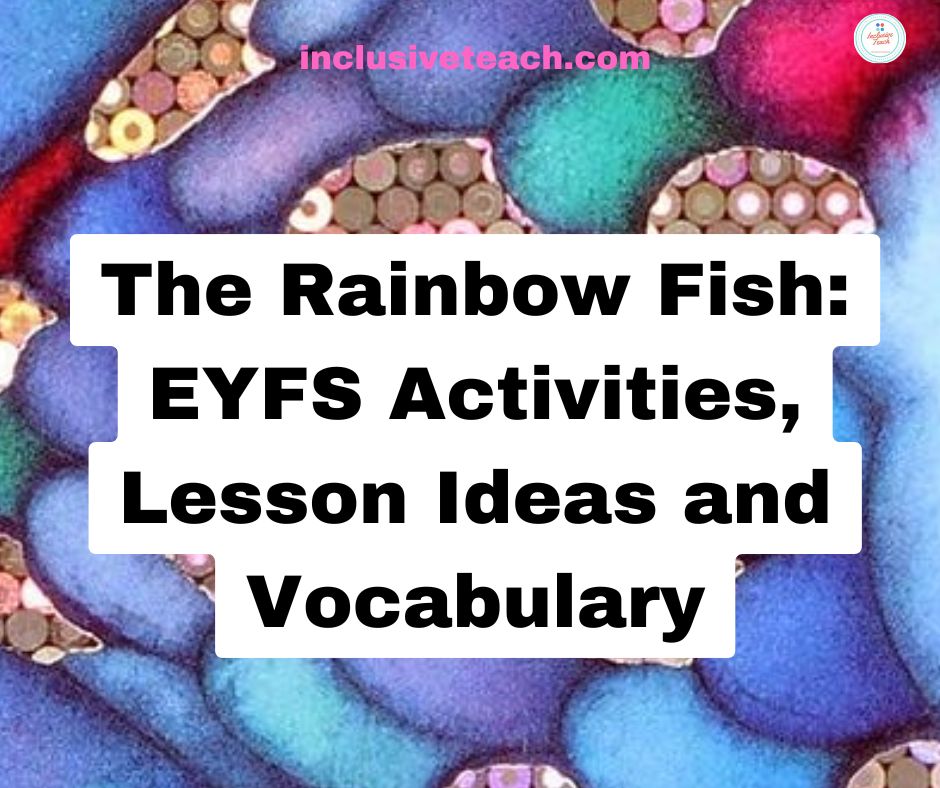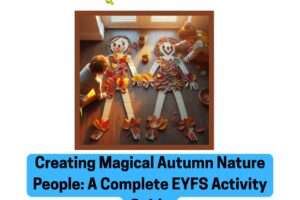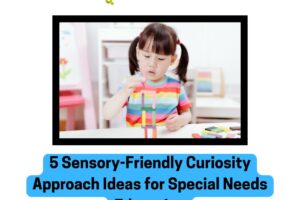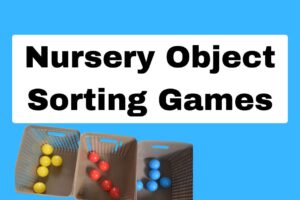
EYFS Activities, Lesson Ideas and Vocabulary
The Rainbow Fish EYFS Activities and Lesson Plan Ideas
“The Rainbow Fish shared his scales one by one. And at last he felt at home among the fish.”
The Rainbow Fish by Marcus Pfister is more than just a story about a glittery fish. It’s a gentle, visual introduction to big feelings and early social skills. Beneath the shimmer lies a relatable story for young children just beginning to explore what it means to make friends, share what they value, and find their place in a group. In Early Years Foundation Stage (EYFS) settings, where emotional development is just as important as early literacy and number sense, this story provides the perfect springboard for meaningful exploration through play, talk, and creativity.
The story follows a beautiful fish who refuses to share his shiny scales with others and finds himself feeling lonely as a result. After seeking advice from a wise octopus, he chooses to give away some of his scales and discovers the joy of connection and belonging. For young children navigating their first friendships and classroom routines, this message resonates. But how we explore that message matters. We don’t need to use it to teach that sharing is always the right thing. Instead, we can use it to open conversations about choices, kindness, and inclusion, while offering hands-on learning experiences that bring the story to life.
Start with a shared read-aloud. Hold the book up so all the children can see the shimmering foil illustrations and pause at key points to invite their thoughts. What do they notice about the other fish? Why do they think the Rainbow Fish is sad? How do they think the little blue fish felt when he was ignored? These moments of reflection don’t have to be formal, they can happen in the natural back-and-forth of discussion, with plenty of encouragement for children to use their own words, gestures, or AAC tools.
Why Choose The Rainbow Fish for EYFS?
Marcus Pfister’s story follows a beautiful fish with glimmering scales who learns that sharing and connection bring more joy than keeping treasures to himself. It’s short, accessible, and visually striking—making it ideal for whole-class reading with plenty of prompts for talk.
The book can be used to explore:
- Personal, Social and Emotional Development: What does it feel like to be left out? What does kindness look like?
- Communication and Language: Retelling stories, using descriptive language.
- Expressive Arts and Design: Creative responses through collage, painting, and music.
- Understanding the World: Ocean life, underwater environments, friendship groups.
🐠 EYFS Lesson Plan: A Day with The Rainbow Fish
Here’s a sample day plan built around the story. You can use it as a standalone session or part of an “Under the Sea” or “Friendship” theme.
Story Time (30 mins) – Read and Reflect
Objective: To develop listening and comprehension skills, with a focus on emotional literacy.
What to do:
- Read The Rainbow Fish aloud. Pause at key points to ask reflective questions:
- “Why do you think the other fish swam away?”
- “How did Rainbow Fish feel when he was alone?”
- “What changed after he shared his scales?”
- Use feeling cards or emojis to support understanding of emotions.
- Encourage children to relate the story to their own experiences of sharing (or not sharing).

Creative Activity – Make Your Own Rainbow Fish (45 mins)
Objective: To explore colour, texture, and personal identity.
Setup:
- Give each child a fish-shaped cut-out on card.
- Provide collage materials: tissue paper, foil, sequins, coloured cellophane, buttons, glue, and crayons.
Instructions:
- Ask children to decorate their fish however they like, using at least one “sparkly” scale.
- Optional extension: Let each child give one scale to a friend’s fish, encouraging gentle discussions around sharing and consent.
EYFS Links:
- Fine motor development
- Expressive arts
- Exploring personal preferences
Circle Time – Talking About Feelings (15 mins)
Objective: To develop vocabulary and empathy around emotions.
What to do:
- Display images of Rainbow Fish at different points in the story and ask: “How is he feeling here?”
- Introduce simple emotion vocabulary: happy, lonely, proud, sad, kind.
- Use mirrors or emojis for children to practise recognising and copying expressions.
Maths Activity – Counting Sparkly Scales (20 mins)
Objective: To practise counting and number recognition.
Resources:
- Fish templates with numbered spots.
- Sparkly sticker “scales” or tokens.
Instructions:
- Children count and stick the correct number of shiny scales onto each fish.
- Extend by using a dice and asking children to roll, count, and add that many scales to their fish.
Adaptation: Use large tongs and glitter pom-poms for a fine motor twist.
Role Play – Underwater Friendship Zone (30 mins)
Objective: To encourage cooperative play and imaginative thinking.
Setup:
- Create a blue “underwater” play space using fabric, paper seaweed, and cardboard fish.
- Add hats or headbands to represent the characters from the story.
Play ideas:
- Re-enact the story together or let children come up with their own underwater tales.
- Offer sentence starters: “Can I share my scale with you?” or “Let’s swim to the treasure!”
EYFS Focus:
- Language and social interaction
- Story sequencing through play
Differentiation & Inclusion Tips
Not every child finds sharing easy—and that’s OK. Here are ways to make sure this book and your activities work for a range of needs and preferences:
- Offer alternatives: If a child doesn’t want to give away their sparkly scale, allow them to keep it. Frame sharing as a choice, not a rule.
- Use visuals: Support understanding with symbol-supported materials, now/next boards, and feelings visuals.
- Allow parallel play: Some children may engage more through quiet art or observing others play.
- Make it sensory: Offer calming sensory fish (gel bags, sparkly water bottles) for children who need a sensory break.
- Celebrate difference: Talk about how all the fish are different, and that’s what makes the ocean interesting.
Extension Activities for a Rainbow Fish Theme
- Ocean Small World: Set up a water tray with pebbles, toy fish, and glitter to mimic the ocean. Include Rainbow Fish characters.
- Music & Movement: Use scarves and flowing music to pretend to swim through the sea. Try “Rainbow Fish Says” (a twist on Simon Says).
- Under the Sea Song Time: Sing themed songs like Slippery Fish or 1, 2, 3, 4, 5 Once I Caught a Fish Alive.
- Literacy Centre: Create a “Rainbow Fish Writing Table” with story cards, drawing prompts, and sticker scales.

Top 20 Rainbow Fish Vocabulary Words for EYFS
- Rainbow
- Scales
- Sparkly
- Share
- Lonely
- Shimmer
- Kindness
- Friend
- Ocean
- Swim
- Sea
- Fish
- Beautiful
- Deep
- Shell
- Starfish
- Ripple
- Splash
- Coral
- Glisten
Conclusion
The Rainbow Fish remains a favourite for good reason—it’s visually magical, emotionally rich, and deeply relatable to young children. But the way we present its message matters. Instead of insisting on sharing as a moral absolute, we can focus on consent, generosity, and connection, letting children experience what it means to be part of a caring group—on their terms.
Whether you’re using it for one session or building a week around it, Rainbow Fish activities offer more than sparkle. They create meaningful, inclusive opportunities for play, creativity, and emotional learning.

Related
Discover more from Special Education and Inclusive Learning
Subscribe to get the latest posts sent to your email.
Source link





